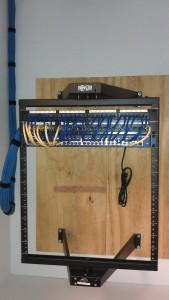
Why Your Company Should Avoid CCA Cabling – Part 1
 If your company has a limited budget for network infrastructure, your team may be tempted to find numerous way to economize. Unfortunately, this may lead to buying CCA cabling in order to save money. Although marketed as a sufficient substitute for solid copper cabling, CCA cables are far from being the right answer for trimming budgets.
If your company has a limited budget for network infrastructure, your team may be tempted to find numerous way to economize. Unfortunately, this may lead to buying CCA cabling in order to save money. Although marketed as a sufficient substitute for solid copper cabling, CCA cables are far from being the right answer for trimming budgets.
Definition of CCA
CCA stands for copper coated aluminum. A CCA cable’s core is an inner aluminum conductor that is coated with copper. As a result, it weighs considerably less than solid copper cables.
A CCA cable can be made at a significantly reduced cost than the solid copper version. This gives a manufacturer an increased profit margin and a significant competitive edge over those companies who continue making solid copper cable.
CCA cables may look similar and are advertised to function just like standard CAT5e or CAT6 cabling, but they have serious flaws that could result in network issues, business continuity problems, and safety hazards as discussed below.
Non-Compliant
CCA twisted pair cables are non-compliant with UL and TIA standards, which require solid or stranded copper conductors. The National Electrical Code (NEC) also does not provide CCA cabling a valid safety listing. Thus, CCA cables cannot be installed legally if the facility requires CM, CMG, CMP, CMR, or CMX rated cables.
Inflexible
As CCA conductors are brittle and easily break, just transferring a faceplate or patch panel can result in failures. CCA wires have low tensile strength, and they are known to break from shearing or pulling, which can happen during packaging or delivery. Moreover, CCA cables have a very limited bend radius.
Oxidation
Aluminum begins oxidizing very rapidly when it is exposed to air. This oxidation and the resulting corrosion may lead to failed terminations inside the network infrastructure, resulting in connectivity issues.
Part 2 will continue discussing CCA cabling related issues and counterfeit copper cabling.
Progressive Office Cabling
Founded in 1986, Progressive Office’s success has been a direct result of years of commitment to seeking solutions on behalf of our clients in the Washington, D.C. and New York City areas. Efficiently working together, Progressive teams get cabling installed and operating as fast as possible while minimizing disruption and downtime. Call our toll free number (800) 614-4560 today.





 Improperly installed twisted pair
Improperly installed twisted pair 

 As previously discussed, the transition to IP-based security products and the rapid increase in business applications has resulted in end-users expecting greater video, audio, and data integration. These items require delivery over a standardized
As previously discussed, the transition to IP-based security products and the rapid increase in business applications has resulted in end-users expecting greater video, audio, and data integration. These items require delivery over a standardized 

 It is inevitable that applications requiring speeds greater than 100 Mbps and 1000 Mbps will increase. The growing use of wireless devices, high resolution images, HD video streaming, surveillance, and multimedia are straining the capacity of
It is inevitable that applications requiring speeds greater than 100 Mbps and 1000 Mbps will increase. The growing use of wireless devices, high resolution images, HD video streaming, surveillance, and multimedia are straining the capacity of 
 Cabling
Cabling